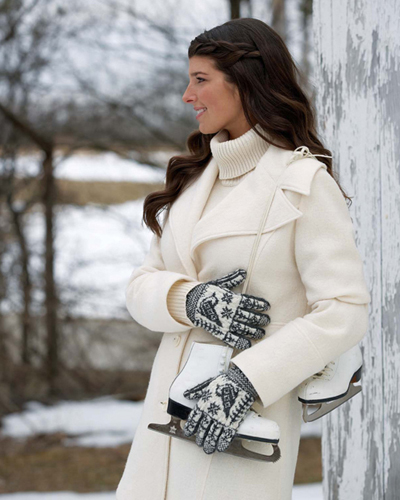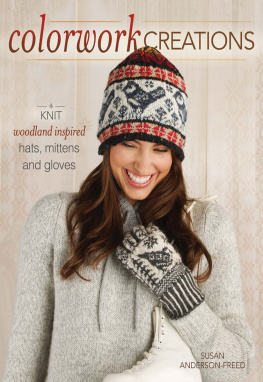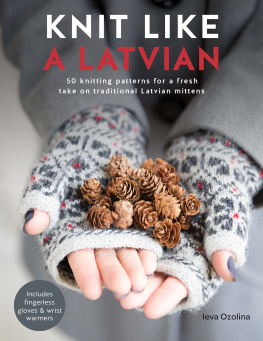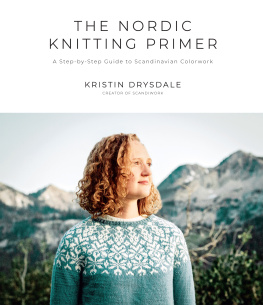COLORWORK CREATIONS
KNIT WOODLAND INSPIRED HATS, MITTENS AND GLOVES
SUSAN ANDERSON-FREED

Colorwork Creations.Copyright 2010 by Susan Anderson-Freed. Manufactured in China. All rights reserved. No part of this book may be reproduced in any form or by any electronic or mechanical means including information storage and retrieval systems without permission in writing from the publisher, except by a reviewer who may quote brief passages in a review. Published by Krause Publications, a division of F+W Media, Inc., 4700 East Galbraith Road, Cincinnati, Ohio, 45236. (800) 289-0963. First Edition.

www.fwmedia.com
14 13 12 11 10 5 4 3 2 1
Distributed in Canada by Fraser Direct
100 Armstrong Avenue
Georgetown, ON, Canada L7G 5S4
Tel: (905) 877-4411
Distributed in the U.K. and Europe by David & Charles
Brunel House, Newton Abbot, Devon, TQ12 4PU, England
Tel: (+44) 1626 323200, Fax: (+44) 1626 323319
E-mail: postmaster@davidandcharles.co.uk
Distributed in Australia by Capricorn Link
P.O. Box 704, S. Windsor NSW, 2756 Australia
Tel: (02) 4577-3555
Library of Congress Cataloging in Publication Data
Anderson-Freed, Susan.
Colorwork creations: knit woodland-inspired hats, mittens, and gloves / Susan Anderson-Freed. 1st ed.
p. cm.
Includes index.
ISBN-13: 978-1-4402-1242-0 (pbk. : alk. paper)
eISBN-13: 978-1-4402-1658-9
1. Knitting Patterns. 2. Hats. 3. Gloves. I. Title.
TT825.A557 2010
746.4322041 dc22
2010004742
EDITOR Rachel Scheller
DESIGNER Kelly O'Dell
PRODUCTION COORDINATOR
Greg Nock
PHOTOGRAPHER Ric Deliantoni
WARDROBE STYLIST
Monica Skrzelowski
MAKE UP ARTIST Cass Brake
SET STYLIST Lauren Emmerling
PHOTOGRAPHY LOCATION
Perfect North Slopes, Indiana
METRIC CONVERSION CHART
To convert | to | multiply by |
Inches | Centimeters | 2.54 |
Centimeters | Inches | 0.4 |
Feet | Centimeters | 30.5 |
Centimeters | Feet | 0.03 |
Yards | Meters | 0.9 |
Meters | Yards | 1.1 |

DEDICATION
To the doctors, nurses and staff of Mid-Illinois Hematology & Oncology Associates, especially Dr. Pramern Sriratana, and to all those whose lives have been touched by cancer.
ACKNOWLEDGMENTS
Many individuals helped make this book a reality, and I would like to thank them for their support and encouragement. Thank you to Matthew Hesson-Mcinnis for first introducing me to knitting gloves from the fingers to the cuffs. Thanks to Deborah Barone for putting me in contact with Jennifer Claydon, an editor at F+W Media. Deborah also test-knit tams and mittens.
Thanks to Jennifer Claydon, who helped me through the initial book conceptualization stages. Thanks to my editor, Rachel Scheller, for guiding me through the production phases. Thank you to book designer Kelly O'Dell and to Ric Deliantoni, the photographer.
I'd also like to thank my husband, John, who tolerated the many bins of yarn filling the family room, and my daughter, Jenny, for test-knitting the tams and hats and gleefully pointing out pattern mistakes.
Finally, I'd like to thank the doctors, nurses, staff and patients of Mid-Illinois Hematology and Oncology Associates. I knit many of the items displayed in this book during chemotherapy and I received many words of encouragement during my weekly chemotherapy sessions. Finally, I would like to thank the volunteers and staff at the Community Cancer Center of Bloomington-Normal.
ABOUT THE AUTHOR
Susan Anderson-Freed learned to knit at the age of nine from her grandmother and has since passed along the craft to her daughter, Jenny. She retired as a Professor of Computer Science at Illinois Wesleyan University in July 2010 after more than thirty years of teaching. Susan lives with her husband, John, two cats and a Golden Retriever. She enjoys cooking, spinning, dyeing, weaving and, of course, knitting in her spare time.
INTRODUCTION
When I was nine, my grandmother from the Upper Peninsula of Michigan came to our home in Green Bay for a weeklong visit. She brought along a set of double-pointed needles, a how-to booklet on knitting and a booklet of mitten patterns. During her visit, Grandma Enoch taught me how to knit. I fell in love with the craft immediately and made several pairs of mittens, the only thing I knew how to make at the time.
The only part I hated about knitting mittens was the thumbs. I wrestled with knitting those few stitches with the weight of the mitten body hanging down, threatening to pull my mitten stitches off their needles. The mausoleum of thumbless mittens in my basement is a testimony to my dislike of knitting the thumbs.
My attitude changed when my friend Matthew Hesson-McInnis gave my daughter, Jenny, a do-it-yourself high school graduation present. Matthew had created a pattern for men's gloves that began at the fingers and ended at the cuff. He wanted a similar pattern for women's gloves, and the beautiful silk and cashmere yarn he included with the instructions for the men's gloves was the only enticement I needed.
As I worked through Matthew's directions, changing the pattern to fit a woman's hands, I thought of the beautiful Fair Isle gloves and mittens I had seen in pattern books. Could I make these gloves and mittens from the fingers or crown to the cuff? Over the next ten years, I designed gloves and mittens constructed in this fashion. Matthew's original design, with its rounded fingers, elaborate gusset increases and decreases and little finger added after the initial fingers, did not lend itself well to Fair Isle knitting. Slowly, I developed patterns and techniques that worked with a variety of knitting traditions, including Fair Isle, knotwork and Sanquhar.
When I embarked on my glove-making adventure, I recalled the lovely Sanquhar patterns that originated in the town of the same name in Dumfriesshire, England. I loved the little boxes of pattern and initially created my versions of the four traditional Sanquhar designs: Duke, Roses, Rose and Trellis, and Drum and Cornet. As a Professor of Computer Science, I couldn't resist the urge to place new designs in those little boxes the number of possibilities was infinite. I added trees, stars and designs adapted from Anatolian sock patterns and Peruvian weaving patterns. As a cancer survivor since 1992 with an ongoing reoccurrence since 2004, I also designed the small bows so often used to signify cancer survival.
Once I constructed the gloves, I turned to adapting the designs to mittens. The patterns lent themselves well to mitten designs, especially when knit from the mitten crown down to the cuff. Salt-and-pepper rounds are used on the crown, and the Sanquhar patterns finish the mitten body. My friends and family encouraged my creativity by asking Could you questions: Could you make me gloves with fingers that end before the first knuckle? or Could you make me those flip-top mittens with a full thumb and a mitten hood? My usual response was, Maybe, and then I tried to accommodate their requests. The creation of fingerless gloves and flip-top mittens followed.











